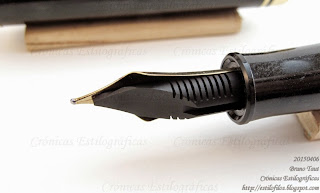The Fountain Pen of the World Festival, as I already explained, is a one-week long event--a week to sell pens by making them more accessible to potential customers. We, pen otaku, barely need these initiatives as we are well aware of the new releases and we often visit those few specialized shops with a good selection of pens, inks and papers. But at the same time, we are a small bunch and the market cannot sustain on us alone. So, the name of the game is outreaching.
The first step is the event itself. And then, what else? During this whole week a number of activities are organized with the obvious purpose of attracting new users.

Fountain pens and paper to try. First tray. Can the reader identify all of them? The comment section welcomes any guess.
A table with about twenty pens, inked and perfectly tuned, and good quality paper welcomed the visitor on the first days. No need to speak, no need to ask. Just sit and write.
But that was not all. Pilot organized some calligraphy lessons to show the virtues of their Parallel pens.
Publisher AI-Books was also present to publicize its specialized magazine Shumi-no Bungubaku. An exhibition displaying the history of S. T. Dupont attracted some other people. And, of course, the pen tuners ready to adjust any nib to your taste and needs by courtesy of each company at each of their counters.

General view of the calligraphy lesson. On the background, the exhibition on the history of S. T. Dupont pens.
Outreaching… No wonder, then, the Japanese fountain pen scene was so active nowadays.
Platinum 3776 (1984) – Parker Quink Blue
Bruno Taut
Nakano, April 17th, 2015
etiquetas: evento, mercado
Bruno Taut
Nakano, April 17th, 2015
etiquetas: evento, mercado








































